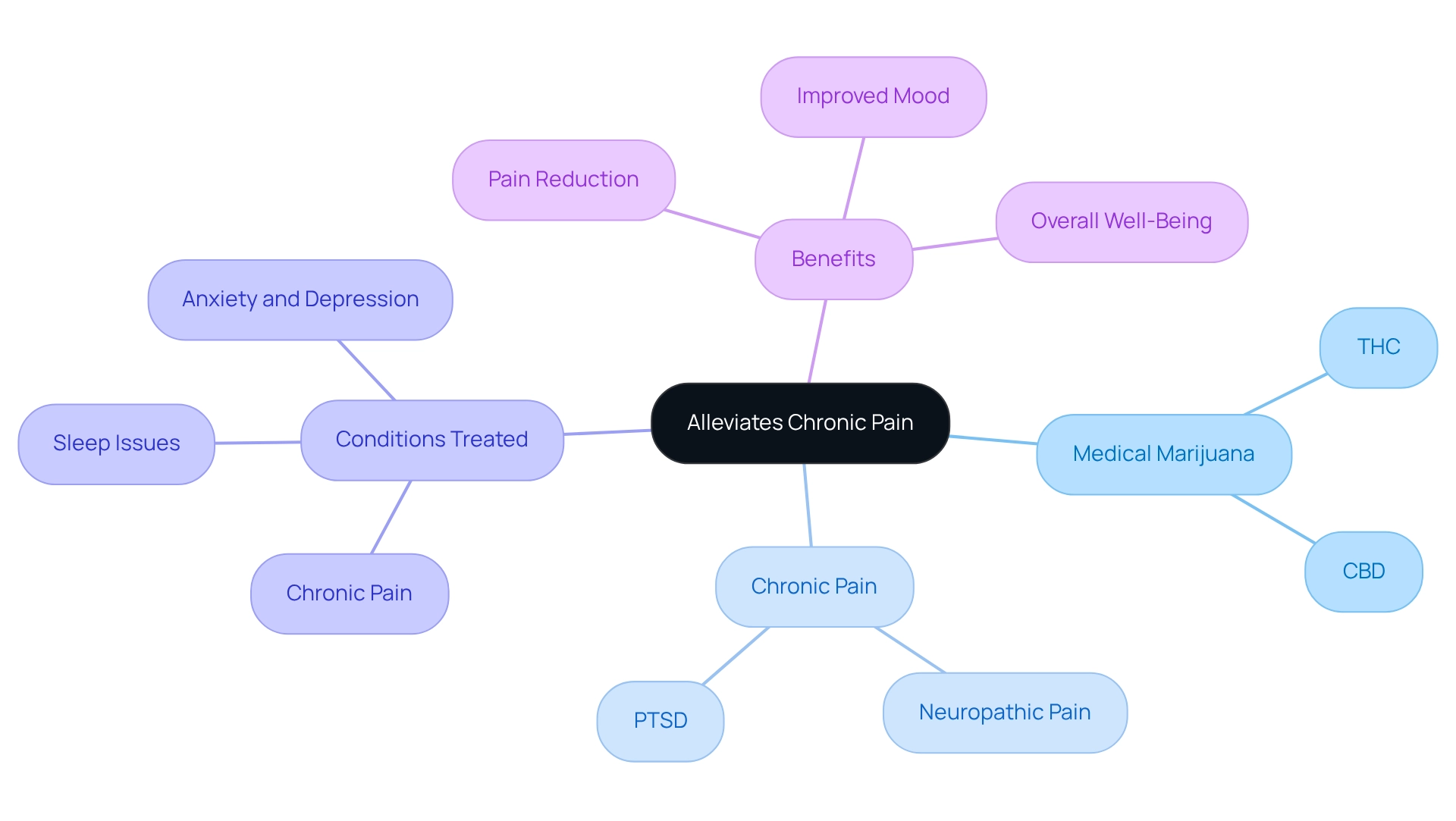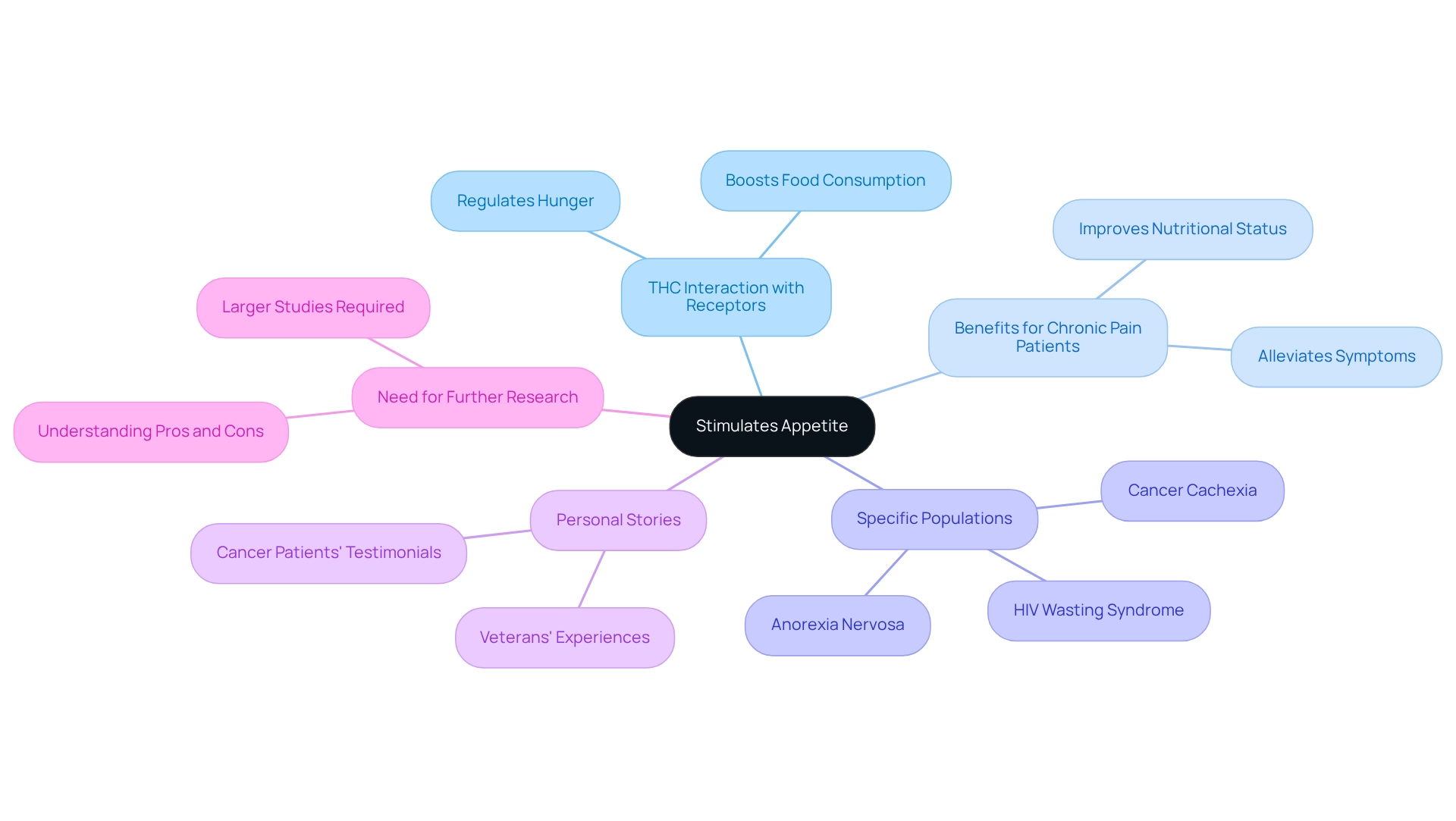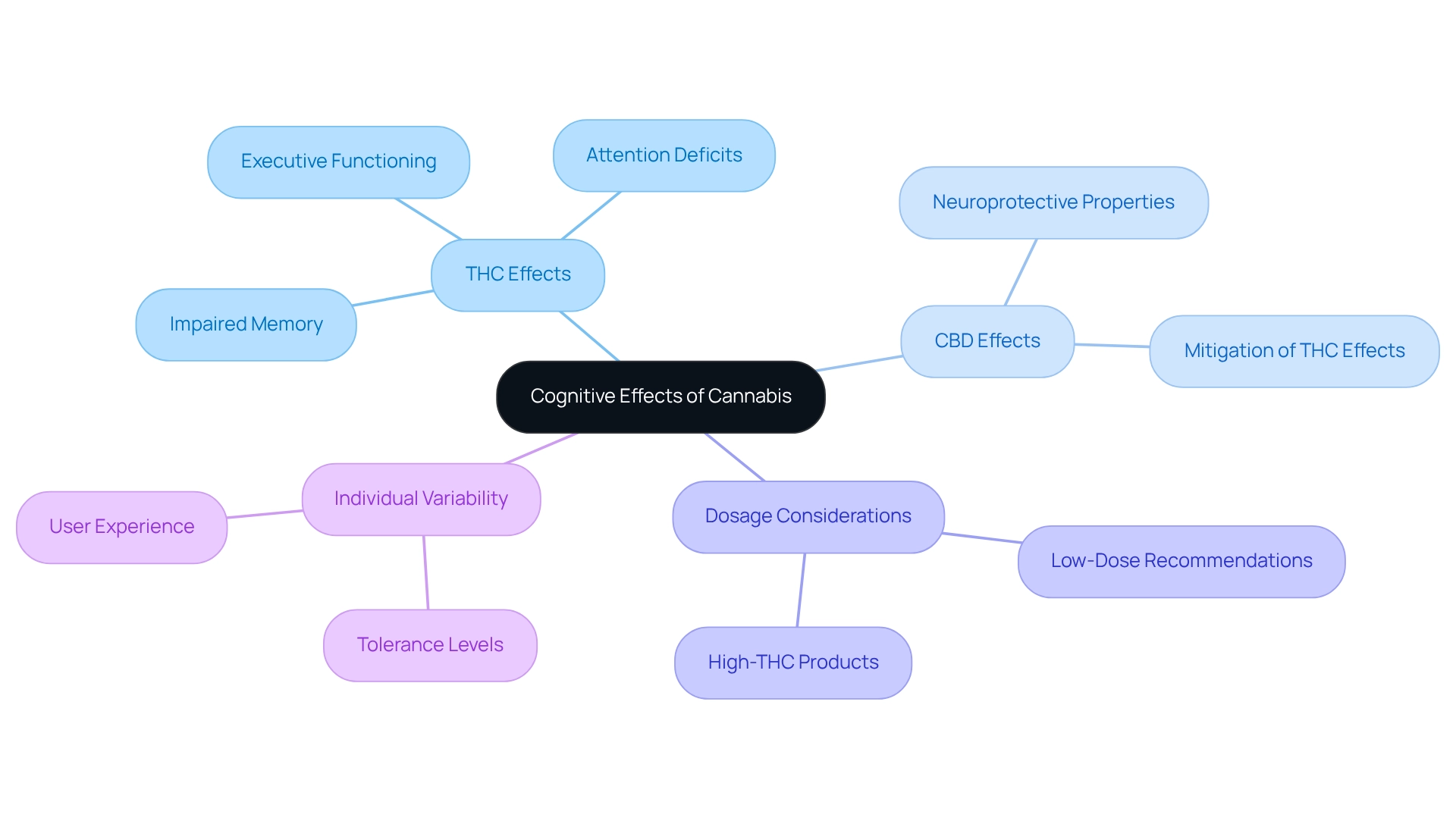Pros and Cons of Medical Marijuanas for Chronic Pain Management
by Maya Green · April 21, 2025
Explore the pros and cons of medical marijuana for chronic pain management in this insightful article.

Overview
This article thoughtfully explores the advantages and disadvantages of medical marijuana in managing chronic pain. Many individuals find relief through its ability to alleviate pain, reduce anxiety, stimulate appetite, and control nausea. However, it’s also essential to consider potential risks, such as dependency and cognitive impairment. By examining various studies and real-world experiences, we aim to provide a comprehensive understanding of this complex topic.
It’s important to remember that each person’s journey with chronic pain is unique. Consulting healthcare professionals can help tailor treatment plans that address individual needs and navigate the legal complexities surrounding medical marijuana use. We encourage you to reflect on your experiences and seek guidance from trusted sources.
As you explore your options, know that you are not alone in this journey. Many have found hope and relief through medical marijuana, and with the right support, you can too. Together, we can work towards finding the best solutions for your well-being.
Introduction
The therapeutic potential of medical cannabis has ignited a profound interest, especially in the journey of managing chronic pain. Many patients are searching for alternatives to traditional pain relief methods, and the multifaceted benefits of cannabis—such as alleviating pain, reducing anxiety, stimulating appetite, and controlling nausea—are becoming increasingly recognized. It’s important to remember that while the evidence supporting its efficacy continues to grow, concerns about dependency, cognitive effects, and the complex legal landscape surrounding its use also emerge.
This article aims to explore the various ways medical cannabis can enhance the quality of life for those enduring chronic pain. You may find that understanding these benefits can be a source of hope. However, it is crucial to emphasize the importance of personalized medical consultation and the need for further research to ensure safe and effective treatment options. Together, we can navigate this path toward better health and well-being.
Alleviates Chronic Pain
Living with chronic discomfort can be incredibly challenging, but there is hope. Medical marijuana has shown effectiveness in reducing pain by interacting with our body’s endocannabinoid system. Cannabinoids, such as THC and CBD, connect to specific receptors in the brain and nervous system, which can significantly lessen how we perceive pain. You may find comfort in knowing that studies indicate around 25% of individuals diagnosed with chronic pain report substantial relief when using marijuana, particularly for neuropathic pain—a condition often resistant to traditional treatments.
It’s also noteworthy that one-quarter of individuals with Post-Traumatic Stress Disorder (PTSD) have indicated using marijuana for pain relief, highlighting a significant connection between these conditions. A CDC report emphasizes the effectiveness of marijuana in addressing neuropathic pain, suggesting it could be a viable alternative for those who haven’t found relief through conventional therapies.
Moreover, real-world experiences with marijuana often report higher rates of pain reduction compared to controlled trials, which suggests that the benefits of cannabinoids may extend beyond what is observed in clinical settings. A systematic review by Stockings et al. found that cannabinoids significantly alleviate sleep issues compared to placebo groups, indicating additional benefits of therapeutic marijuana.
This growing body of evidence supports the use of medical marijuana as a promising option for managing chronic discomfort, especially for those who may have previously used marijuana before obtaining their therapeutic marijuana certification. Furthermore, therapeutic marijuana has been shown to improve mood and overall well-being, offering a holistic approach to addressing chronic pain and related challenges such as anxiety and depression.
If you or someone you know is struggling with chronic discomfort, it may be worth exploring the potential of therapeutic marijuana as part of a comprehensive pain management strategy. Remember, you are not alone in this journey, and there are options available to help you feel better.
Reduces Anxiety Symptoms
Studies highlight the pros and cons of medical marijuana, showing that it can greatly reduce anxiety symptoms, especially in individuals with chronic pain. It’s important to remember that THC, when administered at lower doses, has been found to induce calming effects, while CBD is recognized for its anxiolytic properties, offering relief without the psychoactive effects associated with THC. A study from Harvard Health reveals that patients using marijuana for anxiety frequently report improved mood and reduced stress levels.
However, you may find that it is essential to consider both sides of medical marijuana, as higher doses of THC may inadvertently heighten anxiety. Dr. Cassiday expresses caution regarding the use of marijuana for treating anxiety, particularly its potential to worsen PTSD and depression. This underscores the importance of consulting healthcare providers to determine the optimal dosage and formulation tailored to your individual needs.
Furthermore, cannabis has been found to specifically target and manage seizures in individuals with epilepsy, providing much-needed relief for those affected. Real-world instances demonstrate that many individuals experience a significant decrease in anxiety symptoms when incorporating THC and CBD into their treatment strategies. This emphasizes the importance of customized medical advice in addressing chronic discomfort and related anxiety. As Staci Gruber, PhD, observes, the expectation is that research will elucidate the possibilities for cannabinoid-based therapies as a viable solution for anxiety. This offers insights for clinicians, individuals, and policymakers to make informed choices guided by scientific evidence.
Stimulates Appetite
Cannabis is widely recognized for its ability to stimulate appetite, often referred to as ‘the munchies.’ This phenomenon arises from THC’s interaction with cannabinoid receptors in the brain that regulate hunger. For many individuals experiencing chronic pain, particularly those undergoing treatments like chemotherapy, this appetite stimulation is crucial for maintaining a healthy weight and ensuring proper nutrition. Research indicates that those using medicinal marijuana frequently notice significant increases in food consumption, which correlates with improved overall health.
In medical settings, THC has demonstrated effectiveness in boosting appetite for specific groups, including those facing cancer-related cachexia and HIV wasting syndrome. For instance, studies reveal that regular marijuana use can lead to weight gain in these populations, highlighting its potential benefits in addressing appetite-related issues. Additionally, expert insights suggest that the appetite-stimulating effects of marijuana can be particularly beneficial for individuals with chronic pain, who may struggle with eating due to their condition or the side effects of treatment.
Recent studies have further supported these findings, showing that THC not only enhances hunger but also plays a role in hunger regulation, making it a valuable tool in the therapeutic approach to chronic pain and related appetite loss. Personal stories from individuals, including veterans and those battling cancer, illustrate how therapeutic marijuana has improved their quality of life by alleviating symptoms and enhancing their ability to eat. However, it’s important to remember that more extensive and rigorous studies are needed to fully understand the pros and cons of medical marijuana in symptom management.
Overall, the evidence encourages the use of medical marijuana as a means to boost food intake and improve nutritional status for those facing the challenges of chronic pain. If you or someone you know is struggling with these issues, exploring the potential benefits of medicinal marijuana may be a step worth considering.
Controls Nausea and Vomiting
Medical marijuana has emerged as a compassionate ally in managing nausea and vomiting, particularly for those undergoing chemotherapy. Both THC and CBD have shown significant effectiveness in alleviating these distressing symptoms by interacting with the brain’s receptors that regulate nausea. It’s important to recognize that studies published in the Mayo Clinic Proceedings indicate that individuals using marijuana often report substantial relief from nausea, frequently surpassing the effectiveness of conventional antiemetic drugs. This positions cannabis as a vital option for those grappling with nausea stemming from their medical conditions or treatments.
In a notable case study, an orobuccal spray containing THC and CBD was evaluated in individuals with advanced cancer who were experiencing severe discomfort and nausea. The results revealed early signs of pain relief, particularly among those with breast and prostate cancer, with only mild to moderate side effects reported. This reinforces the potential of cannabinoids not only in pain management but also in enhancing the quality of life for those facing severe treatment-related symptoms. The findings from this case study further illustrate the broader effectiveness of cannabinoids in managing nausea, highlighting their role in comprehensive care.
Additionally, expert opinions underscore the safety of cannabinoids. Dr. Gregory T. Carter has pointed out their remarkable safety profile and the absence of overdose potential. The American Society of Clinical Oncology recommends that FDA-approved cannabinoids, such as dronabinol and nabilone, be considered for treating nausea and vomiting that do not respond to traditional antiemetic medications. As clinical trials continue to explore the antitumoral effects of cannabinoids, the evidence supporting their role in alleviating cancer-related symptoms becomes increasingly robust, making therapeutic marijuana a valuable resource for individuals seeking relief from nausea and vomiting.
Moreover, personal narratives from individuals, including veterans and those with chronic conditions, highlight the transformative health benefits of therapeutic marijuana, reinforcing its significance in modern treatment practices. You may find that exploring these options can lead to a more comfortable and manageable experience during challenging times.
Risk of Dependency
While medical marijuana can offer significant relief for chronic pain, it’s important to thoughtfully consider its pros and cons. One key concern is the potential risk of developing a dependency, particularly with products that have high THC concentrations. Research shows that about 9% of marijuana users may develop a marijuana use disorder, and this figure increases for those who begin using marijuana at a younger age. For daily users, the prevalence of marijuana use disorder can reach as high as 30%.
Individuals with chronic pain may find themselves particularly vulnerable to these risks, as they often depend on marijuana to manage their symptoms. You may be wondering how to navigate this complex landscape. Engaging in open conversations with your healthcare provider about your marijuana use and any concerns regarding dependency is a crucial step. Regular monitoring and adjustments to dosages can be effective strategies to mitigate the risk of developing a substance use disorder. It’s important to remember that maintaining open lines of communication with healthcare professionals is vital for ensuring that your treatment remains both effective and safe.
Leafy DOC plays a vital role in this process by connecting you with licensed healthcare professionals who can provide the necessary guidance and support throughout your treatment journey. Furthermore, it’s essential to understand the varying laws concerning medical marijuana certifications in different states, as these can impact your access to care and the management of your chronic conditions.
By prioritizing these conversations and strategies, you can enhance your quality of life while carefully weighing the pros and cons of medical marijuana, ultimately reducing any potential risks associated with its use.
Affects Cognitive Function
Cannabis use can significantly influence cognitive function, particularly in memory, attention, and decision-making processes. It’s important to recognize that research indicates THC, the main psychoactive element of marijuana, can impair short-term memory and overall cognitive performance, especially among inexperienced users or those consuming higher doses. For instance, studies have shown that THC has a strong affinity for CB1 and CB2 receptors, which are crucial for various cognitive functions. This interaction may lead to significant deficits in attention and memory retention, along with lasting impairments in executive functioning. Conversely, emerging evidence suggests that CBD, another primary cannabinoid found in the plant, may possess neuroprotective properties that could mitigate some cognitive impairments associated with THC. This duality highlights the importance of understanding individual reactions to marijuana, especially for those who may need to engage in activities requiring sustained focus.
For those experiencing chronic discomfort, grasping the dosage and effects of marijuana-infused products, such as honey, is crucial for safe and effective use. Cannabis-infused honey can vary in THC and CBD concentrations, which directly impacts dosage considerations. Starting with a low dose and adjusting based on individual tolerance can help manage potential side effects, such as drowsiness or dry mouth, which can be particularly concerning for those managing daily responsibilities. Real-world examples illustrate these effects; individuals using high-THC products have reported challenges in maintaining focus and recalling information. Leafy DOC enables access to therapeutic marijuana, ensuring that individuals are aware of these cognitive factors, which is essential for effective discomfort management. Recent studies underscore the necessity for large-scale, longitudinal research to fully assess the long-term cognitive impacts of marijuana use, as well as the potential for varying effects based on dosage and individual tolerance levels.
In summary, while marijuana can offer relief for chronic pain, patients should carefully weigh the pros and cons of medical marijuana, particularly its cognitive effects on memory and attention, to ensure they can manage their daily activities effectively. Additionally, consulting with a healthcare professional can provide personalized guidance on managing side effects and optimizing the therapeutic benefits of cannabis-infused honey.
Legal and Regulatory Challenges
The legal standing of therapeutic marijuana in the United States can feel overwhelming and confusing, reflecting the many pros and cons of medical marijuanas that vary significantly from state to state. While some states have embraced cannabis for therapeutic use, implementing supportive regulations, others maintain stringent restrictions or outright bans. This patchwork of regulations can create obstacles for individuals trying to navigate the complexities of medical marijuanas while seeking their medical marijuana permits and accessing products legally. Currently, marijuana remains classified as a Schedule I substance at the federal level, complicating matters for those seeking treatment and healthcare providers alike.
It’s important to understand the pros and cons of medical marijuanas and the specific regulations in your state to ensure compliance and avoid potential legal issues. For instance, in Colorado, a significant 67.8% of approving clinicians recommended marijuana for 20 or fewer individuals in 2021. This statistic underscores the careful approach many healthcare providers take, which can impact access to therapeutic marijuana. Legal experts stress the importance of knowing local laws, as regulations can differ greatly even between neighboring states.
Patients should also be aware of the qualifying conditions for obtaining a cannabis card, which may include chronic pain, anxiety, and PTSD, along with understanding the pros and cons of medical marijuanas. Some states accept out-of-state health cards, while others do not, making it essential to verify your specific state regulations. To obtain a cannabis marijuana card, patients typically follow these steps:
- Consult a Qualified Healthcare Provider: Obtain a recommendation from a licensed physician who understands cannabis.
- Complete the Application: Fill out the necessary application forms required by your state.
- Submit Documentation: Provide any required documentation, including proof of residency and health records.
- Pay Fees: Pay any applicable fees associated with the application process.
- Obtain Your Card: Once approved, you will receive your marijuana card, allowing you to purchase products from licensed dispensaries.
Real-world examples highlight the challenges individuals face, such as lengthy application processes and varying requirements for obtaining marijuana cards, which reflect the pros and cons of medical marijuanas. These challenges emphasize the need for platforms like Leafy DOC, which simplify the application process and guide individuals through the complexities of state-specific regulations.
Additionally, resources like the NCSL’s Prescription Drug Legislation Database can help individuals stay informed about state-specific regulations, serving as a practical tool for understanding the legal landscape. As the acceptance of therapeutic marijuana continues to grow, it’s essential for those seeking relief through this alternative treatment to grasp the pros and cons of medical marijuanas and remain aware of these legal hurdles.
Possible Side Effects
While many individuals find substantial benefits from medical marijuana, it’s important to consider both its advantages and potential side effects. Commonly reported side effects include dry mouth, dizziness, increased heart rate, and fatigue. Additionally, some users may experience heightened anxiety or paranoia, especially when using high-THC strains. Understanding the proper dosage of cannabis-infused products, like honey, is essential for safe and effective use, particularly for first-time consumers. Research shows that the pros and cons of medical marijuana can vary widely among individuals, with studies indicating that about 30% of users report at least one adverse effect. Notably, three reviews have reached different conclusions on the effectiveness of cannabis for various conditions, emphasizing the need for personalized approaches.
Managing these side effects is crucial for optimizing your therapeutic experience. For instance, staying hydrated or using saliva substitutes can often relieve dry mouth. Dizziness may be alleviated by adjusting dosages or opting for strains with lower THC concentrations. Patients are encouraged to inhale cannabinoids via a vaporizer to avoid harmful substances, which can enhance their overall experience. Many individuals effectively manage these challenges by maintaining open communication with their healthcare providers, allowing for customized modifications to their treatment plans.
Expert opinions highlight the importance of personalized care. As healthcare experts emphasize, understanding the pros and cons of medical marijuana can empower individuals to make informed decisions. Mark A Ware, MBBS MSc, cautions against assuming that the negative effects of recreational marijuana use will be the same with therapeutic cannabinoids. For example, while THC is known for its psychoactive effects, it can also lead to common side effects like anxiety and dizziness. Therefore, it’s advisable to discuss your experiences and concerns with certified healthcare professionals to ensure a balanced approach to your therapeutic use. The situation of Leafy DOC illustrates how the platform has successfully facilitated access to therapeutic marijuana for over 40,000 individuals, underscoring the importance of professional support in managing marijuana use.
Requires Medical Consultation
Consulting with a qualified healthcare provider before starting medical marijuana is crucial, especially for those managing chronic pain. A thorough assessment allows for a personalized approach, helping to determine if marijuana is suitable for your specific conditions and which dosage or strain may be most beneficial. This step becomes even more vital for individuals with existing health concerns or those taking other medications, as interactions can lead to adverse effects. Engaging in a collaborative dialogue with healthcare professionals not only ensures personalized care but also enhances your overall treatment experience.
For instance, Leafy DOC has successfully facilitated access to therapeutic marijuana for over 40,000 individuals, particularly aiding those in remote areas or with mobility challenges. This highlights the importance of expert guidance in navigating the complexities of marijuana treatment, ensuring that you can achieve the best possible results. It’s important to remember that a survey revealed 25% of healthcare professionals responded positively to the inclusion of therapeutic marijuana in treatment plans. Additionally, studies show that the prevalence of EHR-documented therapeutic herb usage in the past year was 4.8%, reflecting a growing acceptance of this substance in healthcare settings.
To maximize the benefits of your discussion, consider preparing questions for your healthcare provider before your consultation. While therapeutic marijuana can offer substantial advantages, it’s also essential to weigh the pros and cons, including potential risks such as side effects and interactions with other medications. Leafy DOC’s commitment to providing a secure, confidential, and efficient service further distinguishes it from competitors, ensuring that you receive the assistance you need throughout your treatment journey. Click now to explore the incredible advantages awaiting you and discover how Leafy DOC can simplify your access to these essential services.
Need for Further Research
Despite the growing acceptance of therapeutic marijuana, many individuals still face uncertainty regarding its benefits and risks, particularly in managing long-term discomfort. It’s important to recognize that current studies often have limitations, highlighting the need for more rigorous clinical trials. These trials are essential to establish standardized dosages, formulations, and treatment protocols. For example, a recent German registry study found that 70% of patients using nabiximols reported over 50% pain improvement after 12 weeks. However, these findings remind us of the necessity for broader research that can validate results across diverse populations.
Experts in the field, including professionals from leading healthcare facilities, emphasize the importance of conducting additional research on marijuana. They advocate for comprehensive studies that assess both the immediate effects and the long-term consequences of marijuana use. This is especially crucial for individuals and healthcare providers who strive to ensure that therapeutic marijuana is utilized safely and effectively. As Dr. Maureen Leehey, a neurology professor at the University of Colorado School of Medicine, expresses, “It means everything to me as a researcher. I need a good variety of products.”
Furthermore, the current landscape of research funding for therapeutic herb studies remains limited, which can impede progress in understanding this area. However, personal stories from individuals highlight the transformative impact of medical marijuana. Veterans with PTSD report experiencing fewer symptoms and a reduced reliance on prescription medications, while cancer patients undergoing chemotherapy often find relief from nausea and improved symptom management. Many individuals with chronic discomfort, including those with multiple sclerosis, prefer marijuana over opioids due to its effectiveness and lower risk of dependency.
The link between diminished FAAH function and a reduced need for postoperative analgesics in women undergoing breast cancer surgery further illustrates the biological factors that may influence marijuana’s effectiveness in managing pain. As the demand for effective chronic discomfort management solutions continues to rise, it is vital for stakeholders to advocate for increased funding and support for clinical trials. By addressing these research gaps, we can gain a better understanding of the potential of therapeutic marijuana as a viable treatment option for chronic pain and other qualifying conditions.
Additionally, platforms like Leafy DOC play a crucial role in facilitating access to therapeutic marijuana, shedding light on how research deficiencies can impact user access and care. By streamlining the application process for cannabis cards, Leafy DOC helps ensure that patients receive the evaluations and certifications they need, bridging the gap between research and practical application.
While using medical marijuana for chronic pain relief may carry potential side effects, such as drowsiness or dry mouth, collaborating closely with a healthcare professional can help manage these risks. Medical cannabis can serve as a standalone treatment for inflammatory conditions, but it is often most effective when used alongside other medications to provide comprehensive relief.
Conclusion
The exploration of medical cannabis for managing chronic pain highlights its significant potential to alleviate discomfort and improve quality of life. Cannabinoids such as THC and CBD interact with the endocannabinoid system, offering relief from pain, anxiety, appetite loss, and nausea—benefits that many patients have found truly helpful.
However, it’s important to approach medical cannabis with caution. Potential risks, including dependency and cognitive impairment, should not be overlooked. Engaging with healthcare providers in discussions about treatment plans is essential to ensure safe and effective use tailored to your individual needs.
Moreover, the necessity for further research remains critical. Comprehensive studies are needed to establish standardized dosages and treatment protocols, enhancing our understanding of cannabis’s efficacy and safety. This knowledge will empower both you and your healthcare professionals to make informed decisions in managing chronic pain.
Platforms like Leafy DOC play a vital role in facilitating access to medical cannabis, helping patients navigate the complexities of obtaining necessary evaluations and certifications. In summary, while medical cannabis offers a promising option for chronic pain relief, informed decision-making and ongoing research are crucial. Together, we can maximize its benefits and minimize risks, ultimately leading to improved outcomes for you, the patient.
Frequently Asked Questions
How does medical marijuana help with chronic pain?
Medical marijuana interacts with the body’s endocannabinoid system, where cannabinoids like THC and CBD connect to specific receptors in the brain and nervous system, significantly reducing pain perception. Studies show that around 25% of individuals with chronic pain report substantial relief when using marijuana, especially for neuropathic pain.
Is there a connection between medical marijuana use and Post-Traumatic Stress Disorder (PTSD)?
Yes, studies indicate that about one-quarter of individuals with PTSD have used marijuana for pain relief, highlighting a significant connection between chronic pain and PTSD.
What does research say about the effectiveness of marijuana for neuropathic pain?
A CDC report emphasizes that marijuana is effective in addressing neuropathic pain, suggesting it could be a viable alternative for those who have not found relief through conventional therapies.
How do real-world experiences with marijuana compare to clinical trials for pain relief?
Real-world experiences often report higher rates of pain reduction with marijuana compared to controlled trials, indicating that the benefits of cannabinoids may extend beyond what is observed in clinical settings.
Can medical marijuana help with sleep issues?
Yes, a systematic review found that cannabinoids significantly alleviate sleep issues compared to placebo groups, indicating additional benefits of therapeutic marijuana.
What are the potential mood-related benefits of medical marijuana?
Therapeutic marijuana has been shown to improve mood and overall well-being, providing a holistic approach to managing chronic pain and related challenges such as anxiety and depression.
How does THC affect anxiety, and what should be considered when using it?
THC at lower doses can have calming effects, while CBD is recognized for its anxiolytic properties. However, higher doses of THC may heighten anxiety, underscoring the importance of consulting healthcare providers to determine the optimal dosage and formulation.
Can medical marijuana help with appetite stimulation?
Yes, THC is known to stimulate appetite, which can be particularly beneficial for individuals experiencing chronic pain, especially those undergoing treatments like chemotherapy. Regular marijuana use can lead to significant increases in food consumption, correlating with improved overall health.
What populations can benefit from the appetite-stimulating effects of marijuana?
THC has demonstrated effectiveness in boosting appetite for specific groups, including those facing cancer-related cachexia and HIV wasting syndrome.
What is the overall conclusion regarding the use of medical marijuana for chronic pain and related symptoms?
The evidence supports the use of medical marijuana as a promising option for managing chronic discomfort, improving mood, and addressing appetite-related issues. However, more extensive studies are needed to fully understand its benefits and risks.
Last Updated: July 3, 2025
Get Approved for Your Medical Marijuana Card in Minutes!

Get Your Medical Card
Connect with a licensed physician online in minutes

Like This Article?
Share with your friends
Table of Contents
Keep Reading
-
Indoor Growing Tips For Successful Cultivation
Ready to take your indoor growing game to the next level? Learn expert tips for successful cultivation and maximize your yields with proven techniques. Click now to discover how to grow healthy plants indoors!
-
The Connection Between Cannabis & Appetite
Learn about the link between cannabis and appetite, including how it can increase appetite and why it may be beneficial for some people.
-
9 Essential THC Potency Calculators for Accurate Dosing
Discover 9 essential THC potency calculators for precise dosing and safer cannabis consumption.







